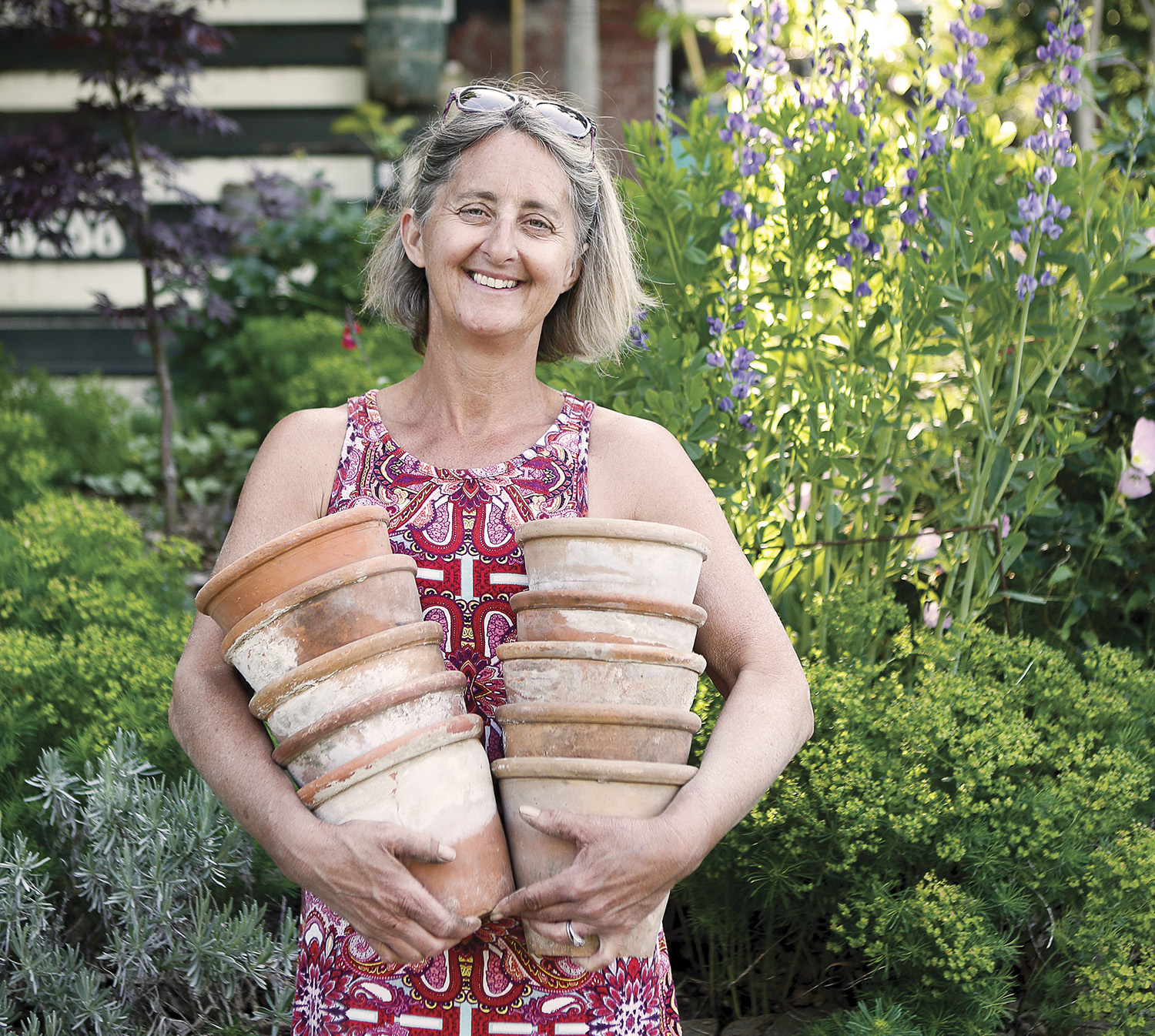
The beginning is nebulous for Kate Fisher. Maybe her cache of gardening pots and planters started in Kentucky. There, she grabbed armfuls of her granddaddy’s pottery while bidding farewell to his estate: a bluegrass holding that had morphed into a mid-’80s bed and breakfast. Or, perhaps it was spurred by a 1997 position at Lost Object, Found Treasures (better known as L.O.F.T.), a homewares and chic boutique then located in Saluda. She learned to scavenge for tchotchkes and bibelots in the garden center, building a taste for curated mayhem.
Or, it could be that the prelude to Fisher’s story is inconsequential. “I must have needed them at some point,” she says, with a shrug in her voice, of the 100 to 200 pots (she has yet to count) scattered about her Madison Avenue bungalow in central Asheville.
Myriad lip balms and chapsticks fill one pot, and ornamental grass grows in another. Wooden kitchen utensils are housed in an olive, asymmetrical vase, and flower bulbs in a hand-sculpted pitcher. Pots rest inside pots like Matryoshka dolls, some even flaunting cherub-like countenances, their noses chipped and weathered by time.
“I may stack pennies in one or food in another,” she explains. “Some are just sprinkled in piles.” The collection is quite the repository: a catchall for bric-a-brac and memories alike.

For instance, a 19-year-old baroque bird’s nest, discovered in a freshly cut spruce the same day Fisher got engaged to her husband James, perches in one terra-cotta pot. Keeping with the avian motif, a nearby planter shelters taupe and Prussian blue eggs. They were the final dozen laid by Isaac Dickson Elementary chickens before a poultry poacher squelched urban farming. “They pulled up all our vegetables, too,” Fisher, a longtime educator, says about the Montford thief. Since the students had raised the hens from chicks, she dried the radiant eggshells for safekeeping.
Though metal buckets and durable, industrial pails make for “cacophonous art” inside and out, a few “unremarkable” pieces symbolize kinfolk. The eldest of three children, Fisher, a Virginia native, was the only child to know the late family matriarch: a doting grandmother with a wicked green thumb. “Grandma thought every word that came out of my mouth was delightful and wonderful,” she reflects. “Some pieces are a reminder that someone loved me so very much.”
Since her own 120-year-old plaster walls are unable to harbor the whole lot, a trail of argil and ceramic pots, testaments to similar stories, continue into the backyard. Thanks to a family gardening bug, evergreens and various perennials are woven in an intricate display. Pots lurk under the back steps and parade on patio furniture.
There’s lots of intention here — a firm aesthetic. Canisters, most of them secondhand, plucked from yard sales or the ScreenDoor, must have an authentic antique flair. Nothing irks Fisher more than a faux patina. Imitation heirlooms pumped off a “conveyor belt in Mongolia,” as she puts it, just downright tick her off, and she can sense when that thumbprint of time has been fabricated. Thus, pot picking is arduous.
“When I’m looking for one, I’m looking for one. I see it, and I go,” she says. “Still, I think of myself as a materialist, if you define it as someone who’s into things and how they’re made.”

Plus, with $60 to $70 counting as a splurge, the pieces also have to be inexpensive. No dainty or ephemeral porcelain lurks behind glass sliders here, especially since the couple’s sons, 13-year-old Sam Hopper and 16-year-old Mac, are fast approaching their father’s 6’5” stature. Rather, aesthetics and functionality should mesh in a dazzling, utilitarian union. It has to be permissible when terra-cotta or concrete shatters out of general wear and tear.
But the frailty of sunbaked adobe can bring rewards. Broken shards carry on a second life as irrigation pebbles for other pots: a becoming reincarnation. Still keeping with that stockpiling mentality, however, Fisher tries to avoid giving up any vessels, no matter how dilapidated or unprepossessing.
“My favorites are these old, handmade pots,” says Fisher. The set, imported from France for her wedding in 1998, are lumpy, asymmetrical, “Dr. Seussical.” She is unaware of their history, but she has an intuition that they are the real deal. “They crack me up. I don’t know if they were fired off in a kiln or a wood stove, so I sit around trying to figure it out. What is their story?”
